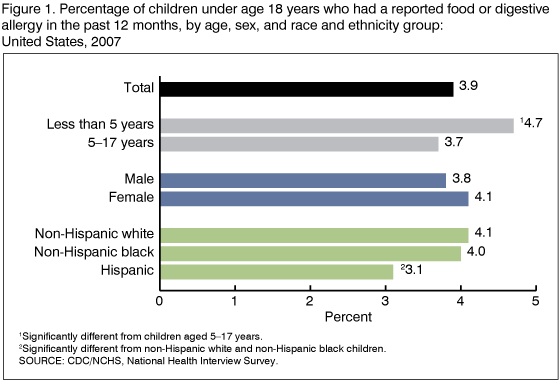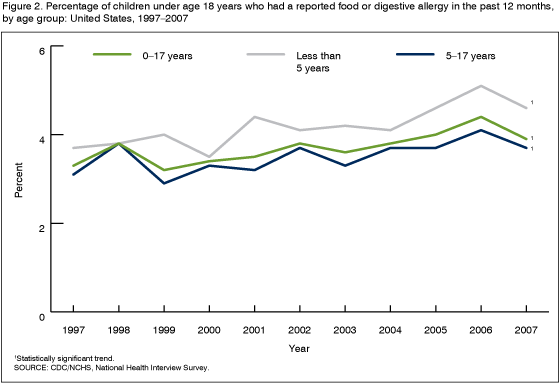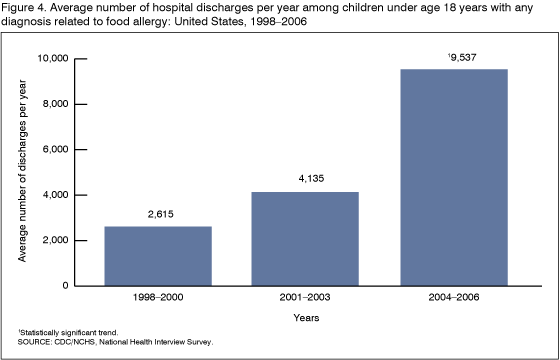Food Allergy Among U.S. Children: Trends in Prevalence and Hospitalizations
On This Page
- Key findings
- Four out of every 100 children have a food allergy
- Food allergy among children in the United States is becoming more common over time.
- Children with food allergy are more likely to have asthma or other allergic conditions.
- Recent data show hospitalizations with diagnoses related to food allergies have increased among children.
- Summary
- Definitions
- Data source and methods
- About the authors
- References
- Suggested citation
NCHS Data Brief No. 10, October 2008
PDF Version (484 KB)
by Amy M. Branum, M.S.P.H. and Susan L. Lukacs, D.O., M.S.P.H.
Key findings
- In 2007, approximately 3 million children under age 18 years (3.9%) were reported to have a food or digestive allergy in the previous 12 months.
- From 1997 to 2007, the prevalence of reported food allergy increased 18% among children under age 18 years.
- Children with food allergy are two to four times more likely to have other related conditions such as asthma and other allergies, compared with children without food allergies.
- From 2004 to 2006, there were approximately 9,500 hospital discharges per year with a diagnosis related to food allergy among children under age 18 years.
Note: See Definitions for an explanation of reported food allergy.
Food allergy is a potentially serious immune response to eating specific foods or food additives. Eight types of food account for over 90% of allergic reactions in affected individuals: milk, eggs, peanuts, tree nuts, fish, shellfish, soy, and wheat (1,2). Reactions to these foods by an allergic person can range from a tingling sensation around the mouth and lips and hives to death, depending on the severity of the allergy. The mechanisms by which a person develops an allergy to specific foods are largely unknown. Food allergy is more prevalent in children than adults, and a majority of affected children will “outgrow food” allergies with age. However, food allergy can sometimes become a lifelong concern (1). Food allergies can greatly affect children and their families’ well-being. There are some indications that the prevalence of food allergy may be increasing in the United States and in other countries (2-4).
Keywords: allergy, National Health Interview Survey, National Hospital Discharge Survey
Four out of every 100 children have a food allergy.

In 2007, an estimated 3 million children under age 18 years (3.9%) had a reported food allergy.
Children under age 5 years had higher rates of reported food allergy compared with children 5 to 17 years of age. Boys and girls had similar rates of food allergy.
Hispanic children had lower rates of reported food allergy than non-Hispanic white or non-Hispanic black children.
Food allergy among children in the United States is becoming more common over time.
In 2007, the reported food allergy rate among all children younger than 18 years was 18% higher than in 1997. During the 10-year period 1997 to 2006, food allergy rates increased significantly among both preschool-aged and older children.

Children with food allergy are more likely to have asthma or other allergic conditions.
In 2007, 29% of children with food allergy also had reported asthma compared with 12% of children without food allergy.

Approximately 27% of children with food allergy had reported eczema or skin allergy, compared with 8% of children without food allergy.
Over 30% of children with food allergy also had reported respiratory allergy, compared with 9% of children with no food allergy.
Recent data show hospitalizations with diagnoses related to food allergies have increased among children.
From 2004 to 2006, there were an average of 9,537 hospital discharges per year with a diagnosis related to food allergy among children 0 to 17 years.

Hospital discharges with a diagnosis related to food allergy increased significantly over time from 1998-2000 through 2004-2006.
Summary
Reported food allergy has increased among children of all ages in the United States over the last 10 years. Nationally representative survey data corroborates reports of increasing food allergy in the United States, and our findings are similar to those reported in other countries. There is some difference in reported food allergy according to Hispanic ethnicity, with lower reported rates among Hispanic children compared with non-Hispanic white and non-Hispanic black children. However, reported food allergy does not appear to differ by sex.
Children with food allergy are two to four times as likely to experience other allergic conditions and asthma than children without food allergy. This is of great importance as children with coexisting food allergy and asthma may be more likely to experience anaphylactic reactions to foods and be at higher risk of death (5,6).
Hospitalizations having at least one diagnosis related to food allergy also increased from 1998-2000 through 2004-2006. This finding could be related to increased awareness, reporting, and use of specific medical diagnostic codes for food allergy or could represent a real increase in children who are experiencing food-allergic reactions.
Definitions
- Reported food allergy, National Health Interview Survey (NHIS): is defined by an affirmative answer to the question “During the past 12 months, has (child) had any kind of food or digestive allergy?”
- Food allergy diagnosis, National Hospital Discharge Survey (NHDS): is defined by the International Classification of Diseases, Ninth Revision, Clinical Modification (ICD-9-CM) codes relevant to food allergy and anaphylaxis related to food allergy.
- Reported asthma (NHIS): is defined by an affirmative answer to the question “Has a doctor or health professional ever told you that (child) had asthma?”
- Reported eczema or skin allergy (NHIS): is defined by an affirmative answer to the question “During the past 12 months, has (child) had eczema or any kind of skin allergy?”
- Reported respiratory allergy (NHIS): is defined by an affirmative answer to the question “During the past 12 months, has (child) had any kind of respiratory allergy?”
Data source and methods
The National Health Interview Survey (NHIS) was used in this analysis to estimate the prevalence of food allergy among children in the United States. The NHIS is a multipurpose health survey conducted by the Centers for Disease Control and Prevention’s National Center for Health Statistics, and is the principal source of information on the health of the civilian, noninstitutionalized, household population of the United States. The NHIS consists of a Basic Module and variable Supplements. The Basic Module, which remains largely unchanged from year to year, consists of three components: the Family Core, the Sample Child Core, and the Sample Adult Core. Questions from the child core related to food allergy, asthma, and other allergic conditions were used for this analysis. The 2007 NHIS questionnaire containing these questions can be viewed at the NHIS website.
The NHIS uses a multistage sample designed to represent the civilian noninstitutionalized population of the United States. In 2007, approximately 9,500 children were sampled. Each sampled child is assigned a weight in order to reflect their representation of the U.S. child population. In order to make estimates on a national level, it is necessary to utilize the person’s basic assigned sampling weight for proper analysis. Therefore, the data for this analysis were weighted to make national estimates.
The National Hospital Discharge Survey (NHDS) was used in this analysis to estimate the number of hospital discharges among children attributable to food allergy. The NHDS is a national probability survey designed to meet the need for information on characteristics of inpatients discharged from nonfederal short-stay hospitals in the United States. The NHDS collects data from a sample of approximately 270,000 inpatient records acquired from a national sample of about 500 hospitals. Only hospitals with an average length of stay of fewer than 30 days for all patients, general hospitals, or children’s general hospitals are included in the survey. Federal, military, and Department of Veterans Affairs hospitals, as well as hospital units of institutions (such as prison hospitals), and hospitals with fewer than six beds staffed for patient use, are excluded.
The NHDS uses a three-stage sampling design procedure to produce national estimates of hospital discharges. Weights are assigned to each sample record. When used collectively, the sample is representative of the United States.
A maximum of seven diagnostic codes was assigned for each sample abstract. Further information about the NHDS can be found at the NHDS website.
The ICD-9-CM codes used to identify food allergy in the NHDS included 477.1 (allergic rhinitis due to food), 558.3 (allergic gastroenteritis and colitis), 692.5 (contact dermatitis due to food in contact with skin) 693.1 (dermatitis due to food taken internally), 995.6 (anaphylactic shock due to adverse food reaction with specific codes for unspecified food, peanuts, crustaceans, fruits and vegetables, tree nuts and seeds, fish, food additives, milk products, eggs, other specified food), and 995.7 (other adverse food reactions not elsewhere classified). Trend tests were performed to evaluate changes in reported food allergy over time using weighted least squares regression. Chi-square tests were performed to evaluate differences in food allergy between groups. All estimates shown have an unweighted sample size of 30 or greater and a relative standard error less than or equal to 30%. All significance tests were two-sided using p < 0.05 as the level of statistical significance. Terms such as “similar” indicate that the statistics being compared were not statistically significant. All data analyses were performed using the statistical packages SAS version 9.1 (SAS Institute, Cary, N.C.) and STATA.
About the authors
Amy M. Branum and Susan L. Lukacs are with the Centers for Disease Control and Prevention’s National Center for Health Statistics, Office of Analysis and Epidemiology, Infant, Child, and Women’s Health Statistics Branch.
References
- Sampson HA. Update on food allergy. J Allergy Clin Immunol; 113:805-19. 2004.
- Sicherer SH. Food allergy. Lancet; 360:701-10. 2002.
- Sicherer SH, Munoz-Furlong A, Sampson HA. Prevalence of peanut and tree nut allergy in the United States determined by means of random digit dial telephone survey: a 5-year follow-up study. J Allergy Clin Immunol; 112:1203-7. 2003.
- Grundy J, Matthews S, Bateman B, Dean T, Arshad SH. Rising prevalence of allergy to peanut in children: data from 2 sequential cohorts. J Allergy Clin Immunol; 110:784-9. 2002.
- Bock SA, Munoz-Furlong A, Sampson HA. Further fatalities caused by anaphylactic reactions to food, 2001-2006. J Allergy Clin Immunol; 119:1016-18. 2007.
- Colver AF, Nevantaus H, Macdougall CF, Cant AJ. Severe food-allergic reactions in children across the UK and Ireland, 1998-2000. Acta Paediatr; 94:689-95. 2005.
Suggested citation
Branum AM, Lukacs SL. Food allergy among U.S. children: Trends in prevalence and hospitalizations. NCHS data brief, no 10. Hyattsville, MD: National Center for Health Statistics. 2008.
Copyright information
All material appearing in this report is in the public domain and may be reproduced or copied without permission; citation as to source, however, is appreciated.
National Center for Health Statistics
Director
Edward J. Sondik, Ph.D.
Acting Co-Deputy Directors
Jennifer H. Madans, Ph.D.
Michael H. Sadagursky
- Page last reviewed: November 6, 2015
- Page last updated: January 19, 2010
- Content source:


 ShareCompartir
ShareCompartir